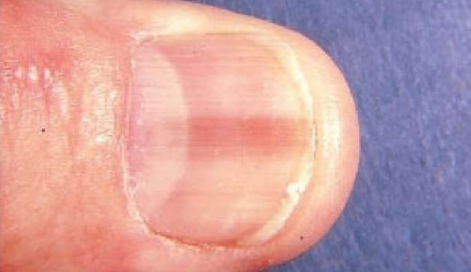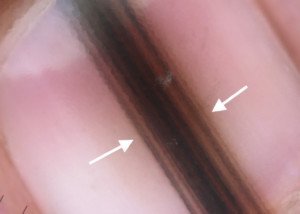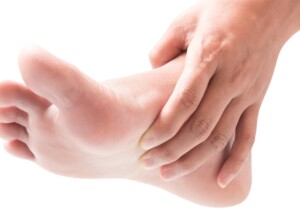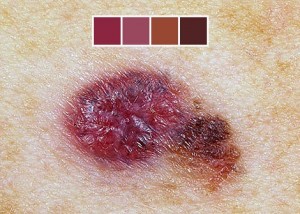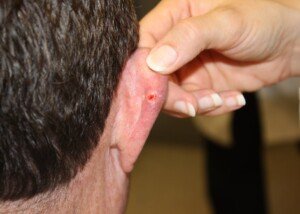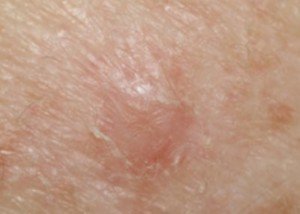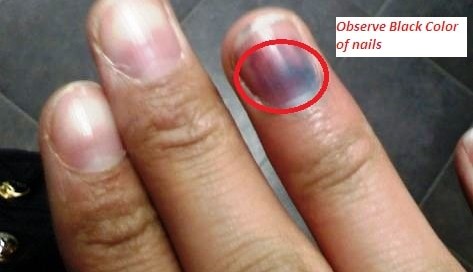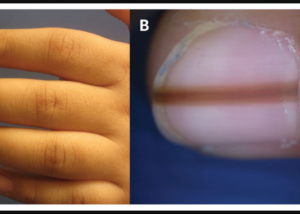Can Colon Cancer Cause Sticky Bowel Movements?

Do your poops seem to have a lot of stickiness or goopy mucus in them?
Do you wonder if colon cancer can cause sticky slimy stools in addition to the more commonly publicized bloody or “tarry” stools? (more…)
Pink Line or Stripe on Fingernail or Toenail Can Be Melanoma
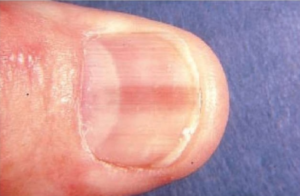
You probably already know that nail melanoma is often a dark line or stripe under the nail, but it can also be pink or a pinkish flesh color. (more…)
What Causes a Pimple to Be Purple? Could Cancer?
If pimples are supposed to be some shade of pink or flesh colored, then what causes a pimple to be purple?
Can You Stop Freckles from Forming in a Preschooler?
This isn’t about reducing the formation of freckles in a preschooler, but outright preventing the little spots from developing anywhere, especially on their face.
How Suddenly Can GERD Begin?
Just how fast can the symptoms of GERD present themselves once the acid starts making its way up the esophagus?
• Does GERD unfold slowly and with stealth?
• Or can its symptoms suddenly come out of the blue?
“GERD can begin very suddenly,” says Alan Gingold, DO, a board certified gastroenterologist with Central Jersey Ambulatory Surgical Center.
“GERD is the movement of stomach contents into the esophagus. Heartburn is a symptom of GERD and occurs in about 50% of people.”
Other Symptoms of GERD
• Chest ache or pain of a non-burning nature
• Upper abdominal pain, ache or a burning sensation
• Burning or pain in the back or between the shoulder blades
• Cough
• Bad taste in the mouth
• Problems swallowing
• Feeling of a lump in the throat
• Burning or sore throat
• Burning in the nose
• Ear pain
When GERD Hits You Suddenly
Dr. Gingold explains, “When the acid comes up into the esophagus, depending on the amount of acid, how sensitive the esophageal mucosa (skin of esophagus) is to the acid and how long the mucosa is in contact with the acid, the symptoms can occur with just one large reflux event.”
Anyone who gets exercise-induced acid reflux will tell you this. Within a few minutes of exercise (usually impact such as running or jumping), that person will start getting an unpleasant taste in the back of their throat or some other symptom such as a slight burning in their chest or upper abdomen.
GERD can also come on quite fast the moment a person lies horizontal at bedtime – especially if shortly before they had a lot to eat.
“This is very true when it happens at night when people are sleeping,” says Dr. Gingold.
“The acid may come in contact with the esophagus for a prolonged period of time and cause significant inflammation and symptoms.”
The heartburn or abdominal discomfort symptoms of acid reflux, when brought on by particular foods, typically do not occur during or immediately after eating.
However, we’ve all at one time or another regurgitated a little food soon after eating it.
 Dr. Gingold attributes his success to the extra time he spends with his patients. His areas of expertise include reflux disease, Barrett’s esophagus, capsule endoscopy, chronic liver disease and inflammatory bowel disease. Dr. Alan Gingold is board certified by the American Board of Internal Medicine in Gastroenterology
Dr. Gingold attributes his success to the extra time he spends with his patients. His areas of expertise include reflux disease, Barrett’s esophagus, capsule endoscopy, chronic liver disease and inflammatory bowel disease. Dr. Alan Gingold is board certified by the American Board of Internal Medicine in Gastroenterology
 Lorra Garrick has been covering medical, fitness and cybersecurity topics for many years, having written thousands of articles for print magazines and websites, including as a ghostwriter. She’s also a former ACE-certified personal trainer.
Lorra Garrick has been covering medical, fitness and cybersecurity topics for many years, having written thousands of articles for print magazines and websites, including as a ghostwriter. She’s also a former ACE-certified personal trainer.
.
Top image: Freepik.com, wayhomestudio
Does GERD Cause Noisy Breathing During Sleep?
GERD can rear its ugly head while a person is asleep, affecting the throat and causing coughing. But what about a strange breathing noise?
This odd overnight noise from acid reflux has nothing to do with snoring or sleep apnea.
“GERD could cause nighttime noise when breathing if someone has enough reflux that the acid is coming up to the back of the throat,” says Alan Gingold, DO, a board certified gastroenterologist with Central Jersey Ambulatory Surgical Center.
“If this is the case, people can have micro-aspiration, meaning that small amounts of the acid go into the lungs, and this could cause asthma type symptoms. This could cause wheezing and noise when breathing.”
The acidic contents make their way into the lungs via the larynx and into the windpipe or trachea, leading to the lungs.
If the accompanying noisy breathing occurs only while one is asleep, this is likely caused by acid reflux – or more specifically, laryngopharyngeal reflux.
Another possible symptom of this is suddenly waking up and having difficulty breathing, or feeling as though your airway has been cut off.
The aspiration can trigger coughing, choking and a sensation of difficulty breathing, which can be distressing enough to wake you up from sleep
In some cases, severe GERD can trigger episodes where the airway becomes partially obstructed, leading to brief pauses in breathing during sleep.
This can result in sudden awakenings and difficulty breathing.
Dr. Gingold explains, “Micro-aspiration might make someone wake from sleep with trouble breathing because the acid and fluid that gets in the lung causes inflammation and coughing which can cause reactive airway disease or symptoms similar to asthma.”
If there’s also an unpleasant or bitter taste in the back of the mouth when this happens, this heavily points to acid reflux as the culprit.
Prevention of Overnight Noisy Breathing and Gasping for Breath
“The best way to prevent micro-aspiration is to make dietary and lifestyle changes that decrease likelihood of reflux,” says Dr. Gingold.
“Avoid food such as citrus, caffeine, spicy foods, alcohol, smoking, fatty foods, chocolate.”
Now of course, giving up favorite foods for life is impossible for most people, but at least you can try to cut back on your consumption of GERD triggers.
“Avoid eating for three to four hours before bedtime, sleep with additional pillows or raise the head of the bed [to angle up the torso] and take your reflux medication,” says Dr. Gingold.
A wedge pillow can be a helpful tool for managing acid reflux during sleep.
The design of a wedge pillow involves an inclined surface that elevates the upper body, which can reduce the likelihood of stomach acid flowing back into the esophagus while lying down.
 Dr. Gingold attributes his success to the extra time he spends with his patients. His areas of expertise include reflux disease, Barrett’s esophagus, capsule endoscopy, chronic liver disease and inflammatory bowel disease. Dr. Alan Gingold is board certified by the American Board of Internal Medicine in Gastroenterology
Dr. Gingold attributes his success to the extra time he spends with his patients. His areas of expertise include reflux disease, Barrett’s esophagus, capsule endoscopy, chronic liver disease and inflammatory bowel disease. Dr. Alan Gingold is board certified by the American Board of Internal Medicine in Gastroenterology
 Lorra Garrick has been covering medical, fitness and cybersecurity topics for many years, having written thousands of articles for print magazines and websites, including as a ghostwriter. She’s also a former ACE-certified personal trainer.
Lorra Garrick has been covering medical, fitness and cybersecurity topics for many years, having written thousands of articles for print magazines and websites, including as a ghostwriter. She’s also a former ACE-certified personal trainer.
.
Top image: Freepik.com
Can a Barium Swallow Be Normal Despite Severe Reflux?

If you’ve been suffering a long time from acid reflux, you may want to ask your doctor about a barium swallow test to screen for Barrett’s esophagus, a precancerous condition.
The damage that the acidic contents from the stomach causes to the inner lining of the esophagus can lead to cellular changes: a change in cells that create a risk factor for esophageal cancer.
A barium swallow is designed to detect anatomical changes such as cancer, but it cannot detect Barrett’s esophagus because Barrett’s is based strictly on biopsy findings.
If someone has had severe acid reflux over a long course of time, is it ever possible for the barium swallow to come up negative?
“A barium swallow can absolutely be normal despite severe reflux, because a barium swallow is made to show changes in anatomy in the esophagus and stomach,” says Alan Gingold, DO, a board certified gastroenterologist with Central Jersey Ambulatory Surgical Center.
“It will show masses or ulcers, but if there is no significant damage from the reflux, the barium swallow may appear normal.”
Barrett’s Esophagus
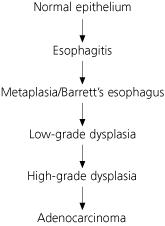
From normal cells to malignant cells.
About two percent of people with Barrett’s esophagus eventually develop esophageal cancer, which has a dismal five year survival rate of a little over 19 percent, according to the National Cancer Institute Surveillance and Epidemiology End Results Program.
Dr. Gingold explains, “Unfortunately, because Barrett’s esophagus is a pathological diagnosis — meaning that it is based on biopsy results, it cannot be followed by barium swallow studies.
“The only way to follow Barrett’s esophagus in patients with reflux is to do an EGD (esophagogastroduodenoscopy or upper endoscopy) every three to five years.”

Upper endoscopy. Shutterstock, Dmitry Kalinovsky
 Dr. Gingold attributes his success to the extra time he spends with his patients. His areas of expertise include reflux disease, Barrett’s esophagus, capsule endoscopy, chronic liver disease and inflammatory bowel disease. Dr. Alan Gingold is board certified by the American Board of Internal Medicine in Gastroenterology
Dr. Gingold attributes his success to the extra time he spends with his patients. His areas of expertise include reflux disease, Barrett’s esophagus, capsule endoscopy, chronic liver disease and inflammatory bowel disease. Dr. Alan Gingold is board certified by the American Board of Internal Medicine in Gastroenterology
 Lorra Garrick has been covering medical, fitness and cybersecurity topics for many years, having written thousands of articles for print magazines and websites, including as a ghostwriter. She’s also a former ACE-certified personal trainer.
Lorra Garrick has been covering medical, fitness and cybersecurity topics for many years, having written thousands of articles for print magazines and websites, including as a ghostwriter. She’s also a former ACE-certified personal trainer.
.
Top image: ©Lorra Garrick
Why Are Acid Reflux and Gas Worse Right Before Menstruation?
Ever notice that your acid reflux or gas worsens right before your period begins? There several reasons for this. It’s not in your head.
“Reflux and gas may be worse right before menstruation for several reasons,” says Alan Gingold, DO, a board certified gastroenterologist with Central Jersey Ambulatory Surgical Center.
“One might be the changing estrogen and progesterone hormone changes that occur right before a menstrual cycle.
“Other things that may make reflux worse at this time are dietary changes — more chocolate, sugars, etc.”
Does your appetite change in the days leading up to the official start of your period?
Cravings for certain foods mean eating those foods – leading to increased acid reflux.
Take note of the changes in diet that occur a few days before you begin flowing.
• Are you eating the same foods as you normally do – but in greater amounts?
• Are you eating more food closer to bedtime, which can lead to acid reflux overnight?
• Are you loading up on comfort foods that are known triggers for acid reflux, such as, of course, chocolate, as well as spicy foods, citrus fruits, soda, orange juice and alcohol?
Dr. Gingold adds, “More non-steroidal medication use at this time may cause more inflammation and irritate the stomach, and in general poor sleep and stress may exacerbate things at this time of the month as well.”
As for gas, this can be explained by the increased intake in food, particularly gas-causing food like beans and, for some women, milk.
And foods with added inulin are notorious for producing a lot of smelly passed gas.
To manage the increased acid reflux that comes around the beginning of your period, avoid eating within three hours of bedtime.
Avoid also the trigger foods for acid reflux and gas (hopefully you’ll be able to eventually identify them).
And remember, more gas than usual is normal in the days preceding menstruation.





